Functional Data Analysis
An Overview
June 4, 2024
Outline
- Definition of Functional Data Analysis
- Examples
- Mathematical Framework
- FDA vs Multivariate Statistics
- Summary Statistics
- Data Representations
- Smoothing Functional Data
- Alignment of Functional Data
- Elastic Method
- Functional Principal Component Analysis
- Vertical
- Horizontal
- Modeling
References
- “Functional Data Analysis”, By James Ramsay, B. W. Silverman
- Standard Textbook covers basic methods with a basis-based approach

References
- “Functional and Shape Data Analysis”“, By Anuj Srivastava, Eric P Klassen
- Recent book on advances using more theoretical foundations
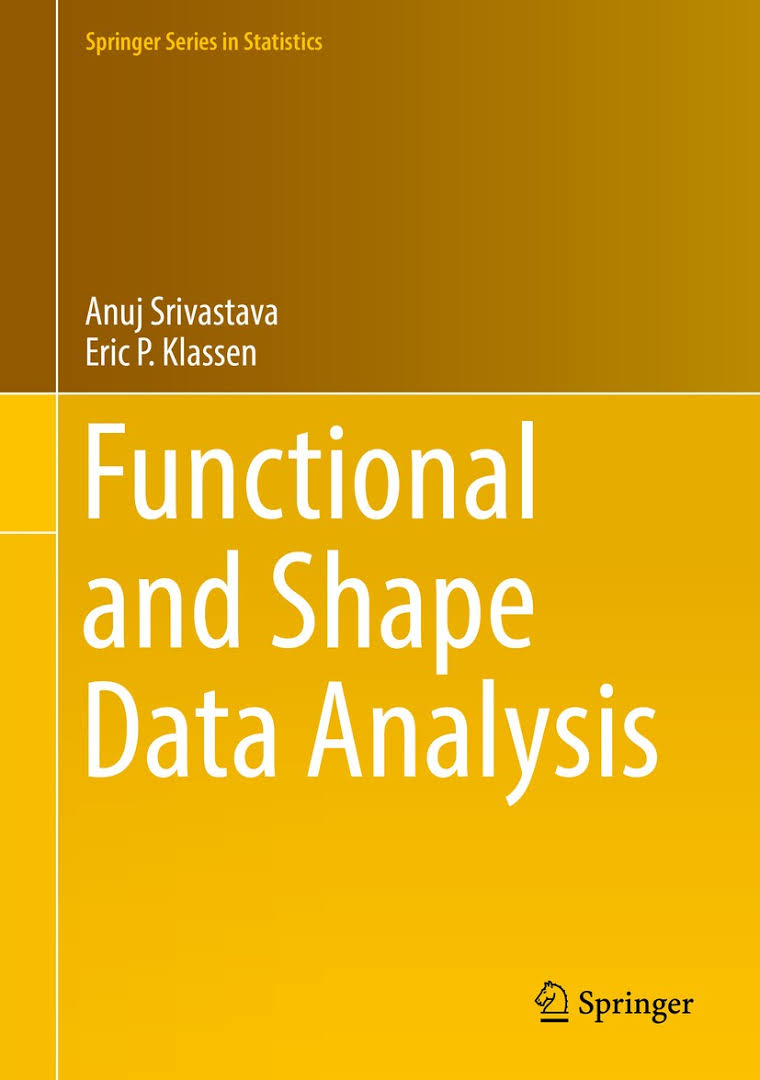
Introduction
- Problem of statistical analysis of function data (FDA) is important in a wide variety of applications
- Easily encounter a problem where the observations are real-valued functions on an interval, and the goal is to perform their statistical analysis
- By statistical analysis we mean to compare, align, average, and model a collection of random observations
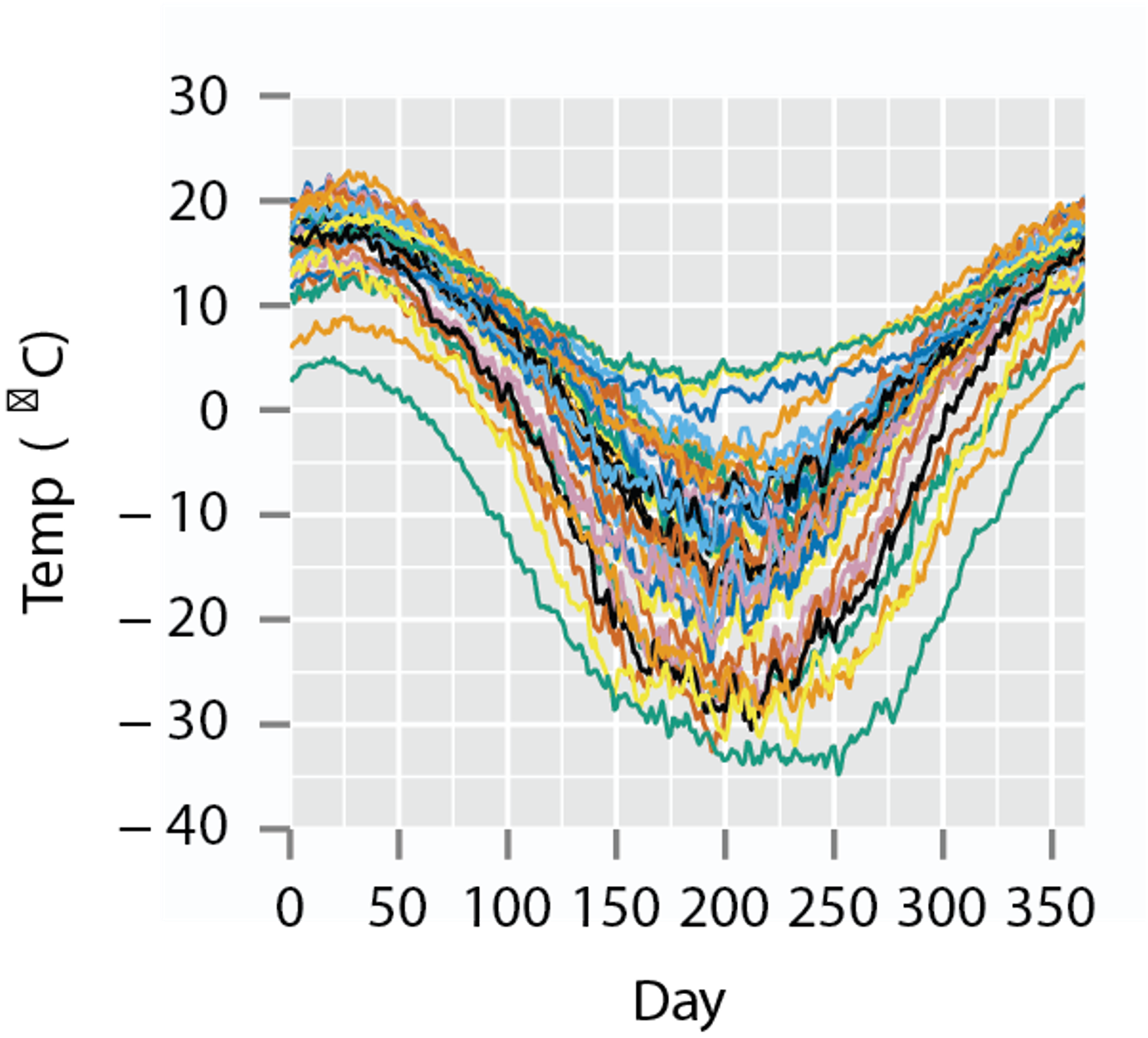
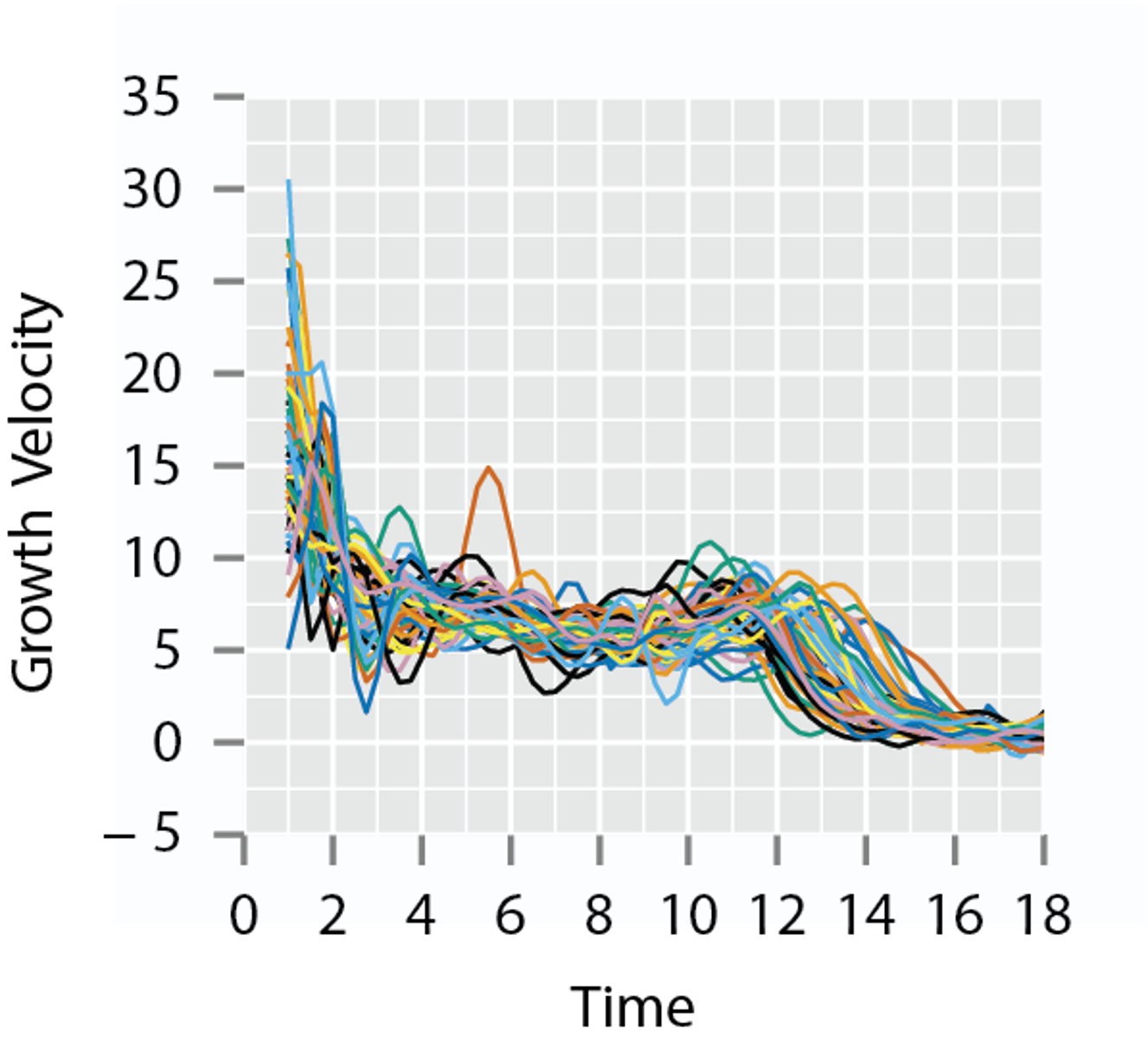

Introduction
- Questions then arise on how can we model the functions
- Can we use the functions to classify diseases?
- Can we use them as predictors in a regression model
- It is the same goal (questions) of any area of statistical study
- One problem occurs when performing these type of analyses is that functional data can contain variability in time (\(x\)-direction) and amplitude (\(y\)-direction)
- How do we account for and handle this variability in the models that are constructed from functional data
Types of Functional Data
- Real-valued functions, with interval domain: \(f:[a,b]\rightarrow\mathbb{R}\)
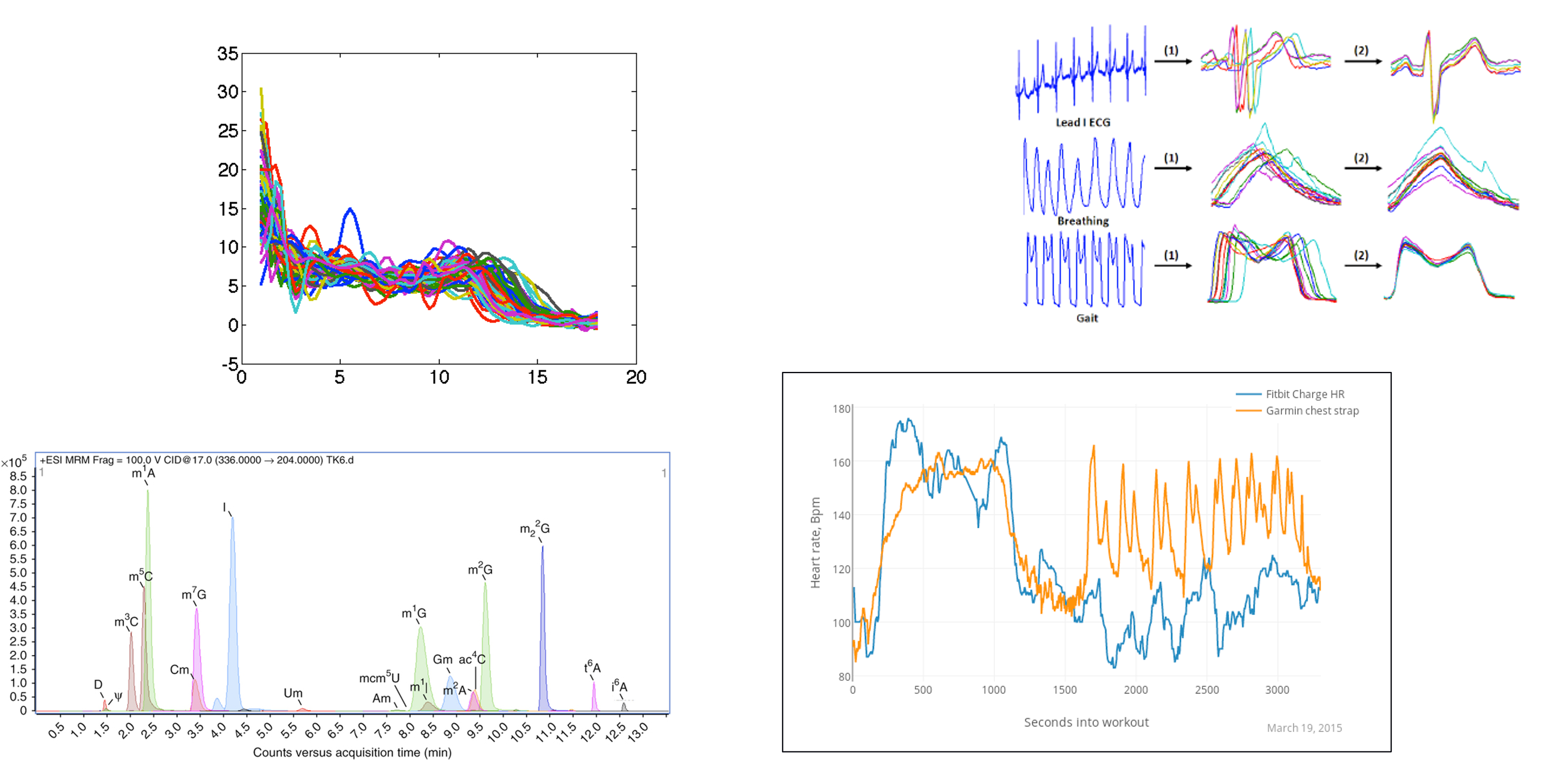
Types of Functional Data
- \(\mathbb{R}^n\)-valued functions with interval domain, Or Parameterized Curves: \(f:[a,b]\rightarrow\mathbb{R}^n\) \(f:S^1\rightarrow\mathbb{R}^n\)
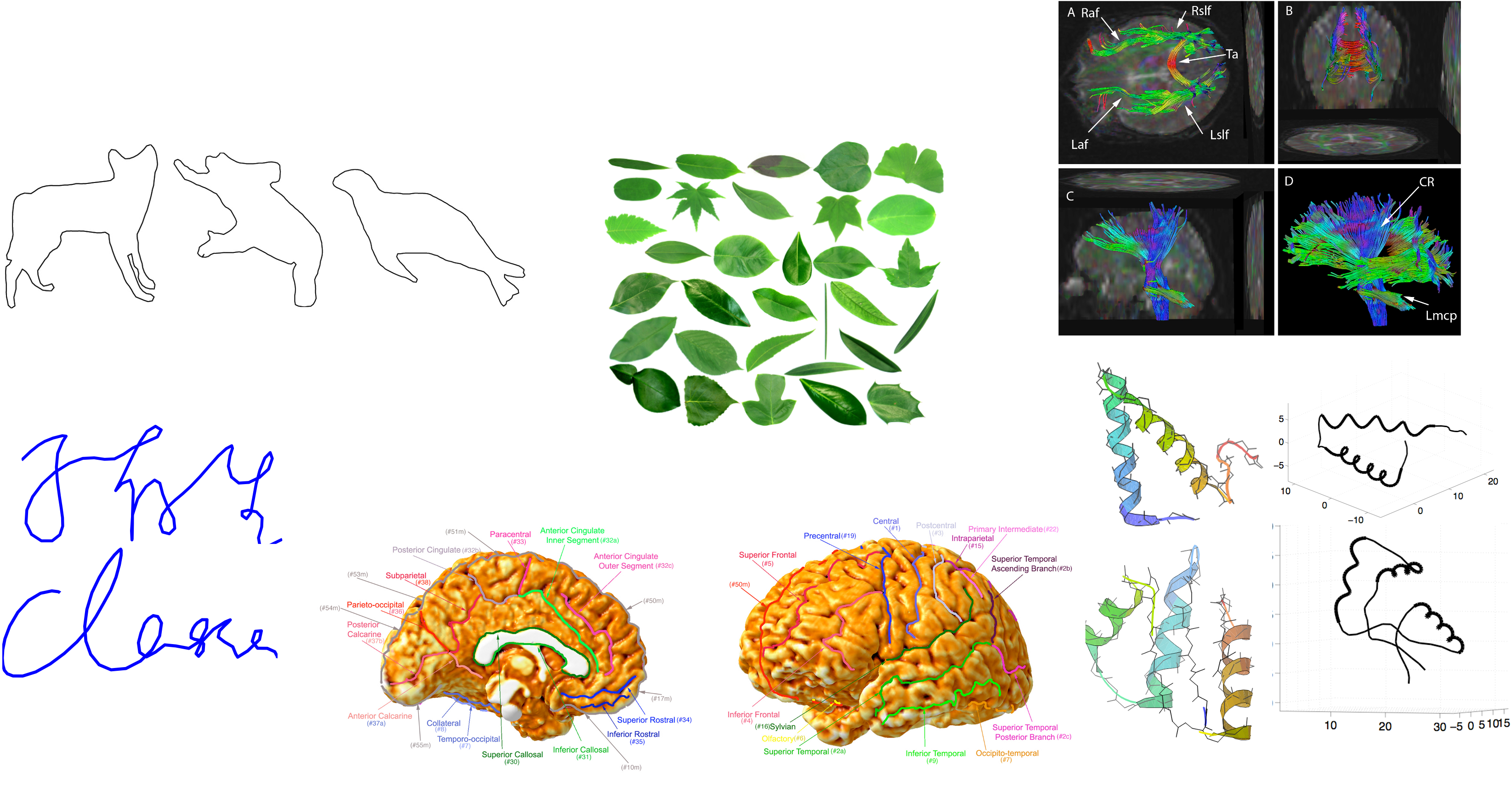
Types of Functional Data
- \(\mathbb{R}^3\)-R3-valued functions on a spherical domain, Or Parameterized Surfaces: \(f:S^2\rightarrow\mathbb{R}^3\)
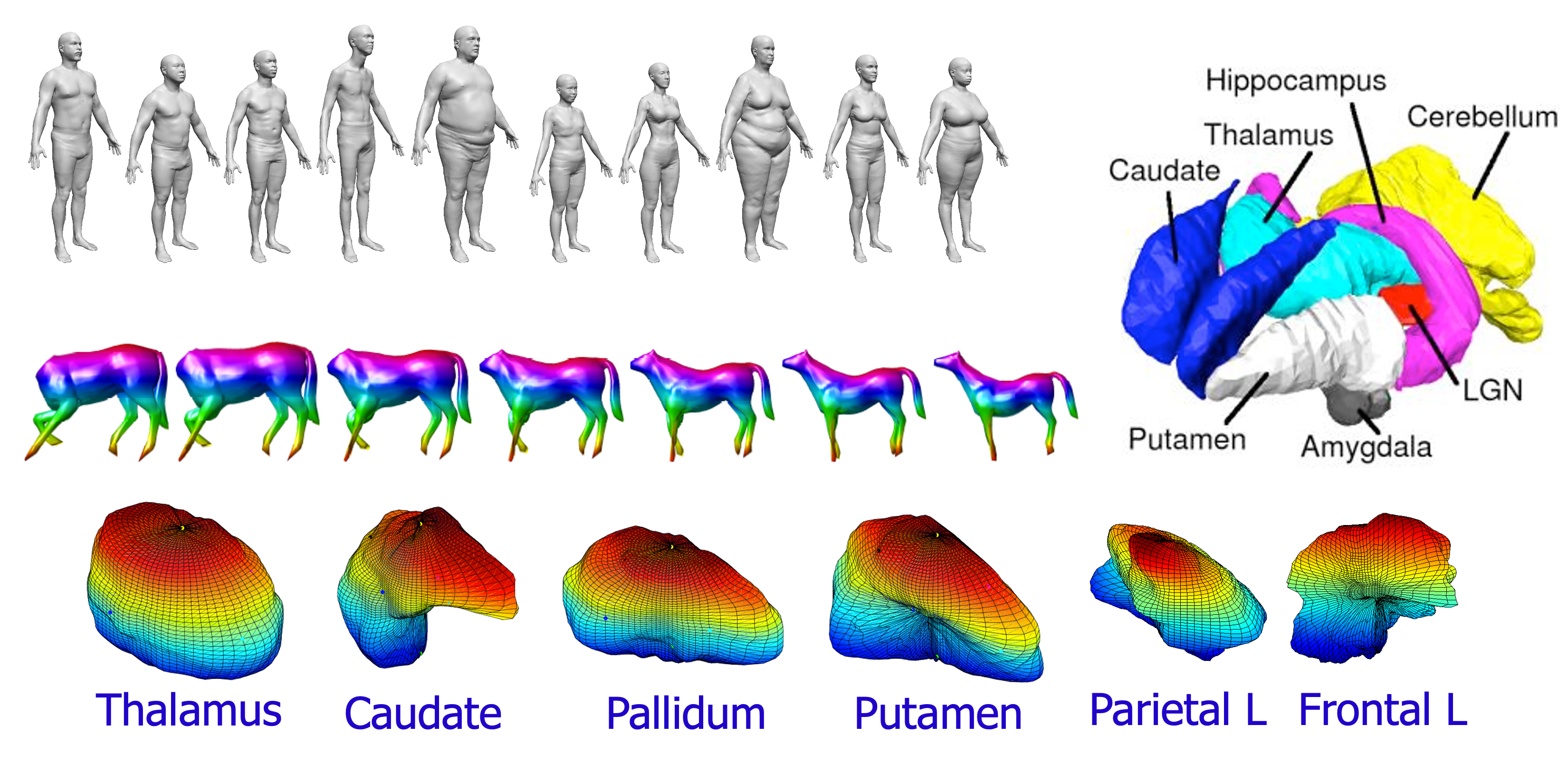
Types of Functional Data
- \(\mathbb{R}^n\)-valued functions with square or cube domains, Or Images: \(f:[0,1]^2\rightarrow\mathbb{R}^n\)


FDA Versus Multivariate Statistics
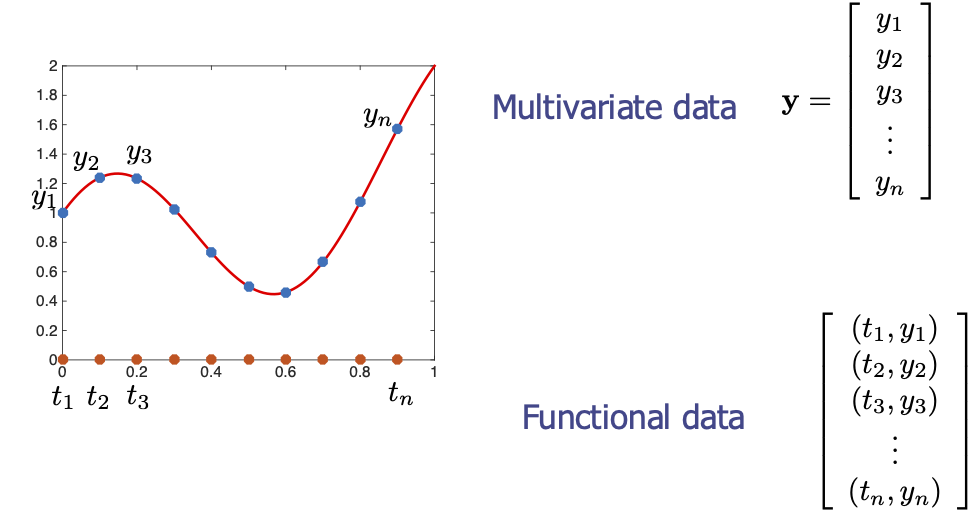
- Not all observations will have the same time indices
- Even if they do, we want the ability to change time indices
FDA Versus Multivariate Statistics
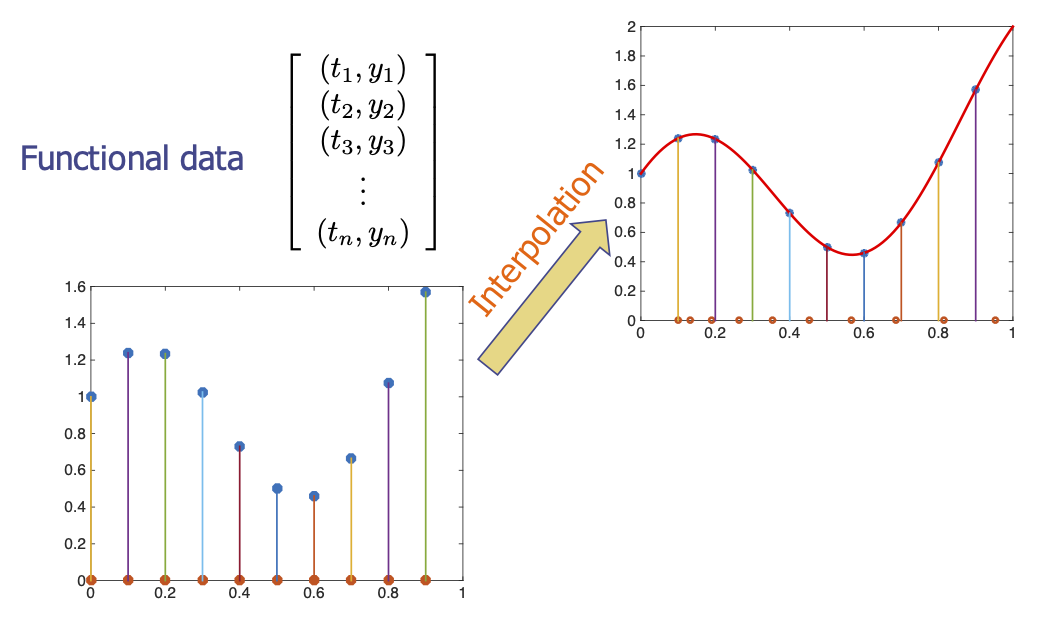
FDA Versus Multivariate Statistics

FDA Versus Multivariate Statistics
- In FDA, one develops the on function spaces and not finite vectors, and discretizes the functions only at the final step – computer implementation.

- Ulf Grenander: “Discretize as late as possible” (1924-2016)
- Even after discretization, we retain the ability to interpolate resample as needed!
Common Metric Structure for FDA
- Let \(f\) be a real-valued function with the domain \([0,1]\), can be extended to any domain
- Only functions that are absolutely continuous on \([0,1]\) will be considered
- The \(\mathbb{L}^2\) inner-product: \[\left\langle f_1,f_2 \right\rangle = \int_0^1 f_1(t)f_2(t)\,dt\]
- \(\mathbb{L}^2\) distance between functions: \[ ||f_1-f_2|| = \sqrt{\int_0^1 (f_1(t)-f_2(t))^2\,dt}\]
- From these we will build summary statistics, but how good are they?
Summary Statistics
- Assume that we have a collection of functions, \(f_i(t)\), \(i=1,\dots,N\) and we wish to calculate statistics on this set
- \[\bar{f}(t) = \frac{1}{N}\sum_{i=1}^N f_i(t)\]
- \[\mathop{\mathrm{var}}(f(t)) = \frac{1}{N-1}\sum_{i=1}^N \left(f_i(t) - \bar{f}(t)\right)^2\]
- and the standard deviation function is the point-wise square root of the variance function
Summary Statistics
- The covariance function summarizes the dependence of functions across different time values and is computed for all \(t_1\) and \(t_2\) \[\mathop{\mathrm{cov}}_f(t_1,t_2) = \frac{1}{N-1} \sum_{i=1}^N \left(f_i(t_1) - \bar{f}(t_1)\right)\left(f_i(t_2) - \bar{f}(t_2)\right)\]
- The correlation function is then computed using \[\mathop{\mathrm{corr}}_f(t_1,t_2) = \frac{\mathop{\mathrm{cov}}_f(t_1,t_2)}{\sqrt{\mathop{\mathrm{var}}(f(t_1))\mathop{\mathrm{var}}(f(t_2))}}\]
- Note: These all assume the functions are aligned in time, if not analysis will be affected
Smoothing Functional Data
- As assumed earlier the construction of functional observations, \(f_i\) is done using discrete data (implementation)
- In some situations, the signal-to-noise ration is low, or the data is noisy, or the discrete observations are few in number
- Can cause problems in generating sufficient summary statistics
- It can be essential to use information in neighboring or similar functions to get better estimates
- The following methods help solve this problem
Representing Functions by Basis Functions
- We can represent a function by a set of basis functions, \(\theta_i\), \(i=1,\dots,k\)
- Basis Types
- Fourier
- B-Spline
- We can represent a function \(f\) by a linear expansion \[f(t) = \sum_{i=1}^p b_i \theta_i\]
- in terms of \(p\) basis functions \(\theta_i\) and coefficients \(b_i\)
- Find the basis coefficients, \(b_i\) by minimizing the least-squares \[{\mathbf b}^* = \mathop{\mathrm{arg\,min}}_{{\mathbf b}}({\mathbf f}- \Theta{\mathbf b})^{\mathsf{T}}({\mathbf f}-\Theta{\mathbf b})\]
Representing Functions by Basis Functions
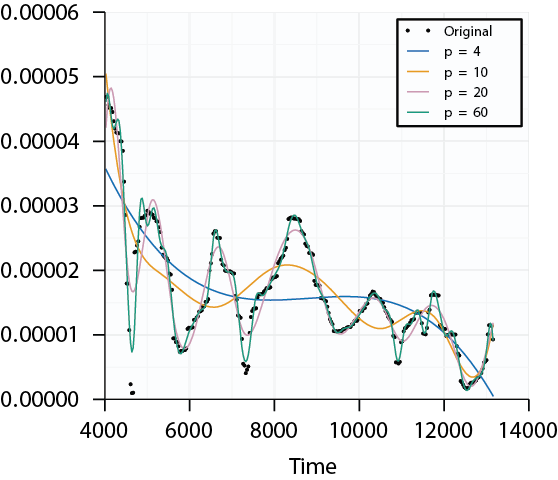
- Setting the dimension of the basis expansion \(p\) we can control the degree to which the functions are smoothed
- Choosing \(p\) large enough we can fit the data well, but might fit any additive noise
Kernel Smoothing
- Another type of smoothing of functional data is kernel smoothing
- The smooth function \(\hat{f}(t)\) is computed at a given point and is a linear combination of local observations \[ \hat{f}(t) = \sum_{i=1}^n S_j(t) f(t_j)\]
- An example of \(S(t)\) is the Nadaraya-Watson estimator \[ S_j(t) = \frac{\mathop{\mathrm{Kern}}[(t_j-t)/h]}{\sum_r\mathop{\mathrm{Kern}}[(t_r-t)/h]}\]
- where \(\mathop{\mathrm{Kern}}\) is a kernel function obeying Mercer’s conditions and \(h\) is the bandwidth of the kernel
Roughness Penalty
- Another popular way to smooth functional data is to add a roughness penalty to the least-squares fit
- The way to quantify the notion of roughness is the square of the second derivative, \([D^2 f(t)]^2\) which is also known as the curvature at \(t\)
- A natural measure of a function’s roughness is the integrated squared second derivative \[ \mathop{\mathrm{pen}}(f) = \int [D^2 f(t)]^2\,dt\]
- Can define a compromise that trades of smoothness against data fit of a basis using the penalized least-squares fit \[ {\mathbf b}^* = \mathop{\mathrm{arg\,min}}_{{\mathbf b}}({\mathbf f}- \Theta{\mathbf b})^{\mathsf{T}}({\mathbf f}-\Theta{\mathbf b})+ \lambda \mathop{\mathrm{pen}}(\Theta{\mathbf b})\]
Roughness Penalty
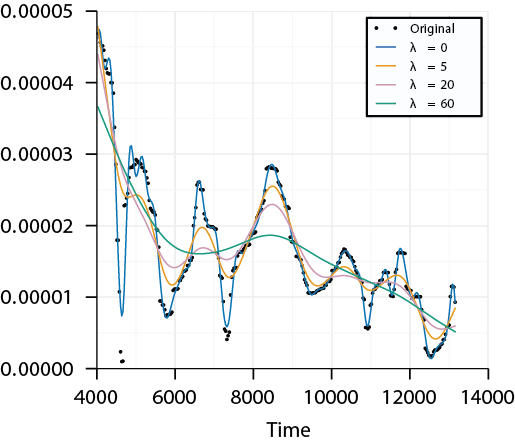
- The parameter \(\lambda\) is the smoothing parameter and controls the amount of smoothing
Functional Principal Component Analysis
- The motivation for functional principal component analysis (fPCA) is that the directions of high variance will contain more information then direction of low variance
- The optimization problem for fPCA \[\min_{w_i} E\|f-\hat{f}\|^2\]
- where \(\hat{f} = \mu_f + \sum_{i=1}^n \beta_i w_i(t)\) is the fPCA approximation of \(f\)
- We then use the sample covariance function \(\mathop{\mathrm{cov}}(t_1,t_2)\) to form a sample covariance matrix \(K\)
- Taking the SVD, \(K=U\Sigma V^{\mathsf{T}}\) we can calculate the directions of principle variability in the given functions using the first \(p\leq n\) columns of \(U\)
Functional Regression
- In functional data analysis, regression modeling is where the function variables are used as predictors to estimate a scalar response variable
- Standard functional linear regression model \[ y_i = \alpha + \int_0^T f_i(t)\beta(t)\,dt+\epsilon_i,~~i=1,\dots,n\]
- where \(\alpha \in \mathbb{R}\) is the intercept, \(\beta(t)\) is the regression-coefficient function and \(\epsilon_i \in \mathbb{R}\) are random errors
- The model parameters are usually estimated by minimizing the sum of squared errors (SSE) \[ \{\alpha^*,\beta^*(t)\} = \mathop{\mathrm{arg\,min}}_{\alpha,\beta(t)} \sum_{i=1}^n |y_i - \alpha - \int_0^T f_i(t)\beta(t)\,dt|^2\]
Phase Amplitude Separation
- All of these methods assume the data has no phase-variability or is aligned
- How does this affect the analysis?
- Can we account for it?
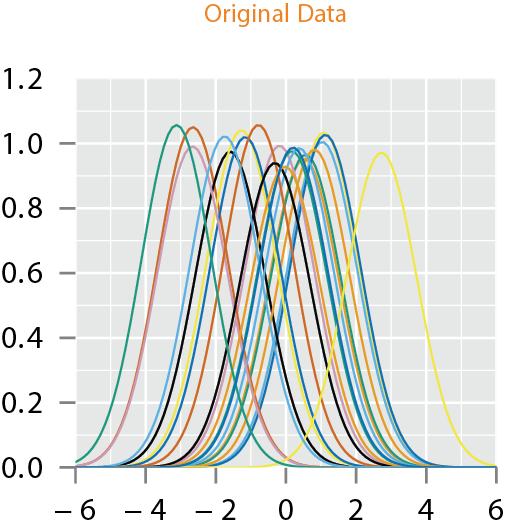
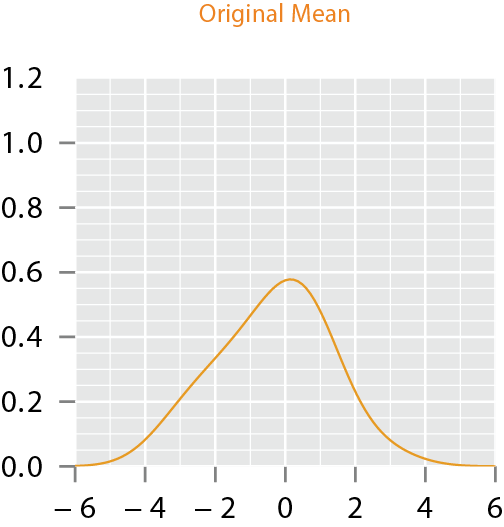
Motivation

- If one performs fPCA on this data and imposes the standard independent normal models on fPCA coefficients, the resulting model will lack this unimodal structure
- A proper technique is to incorporate the phase and amplitude variability, into the model construction which in turn incorporates into the component analysis
Functional Data Alignment
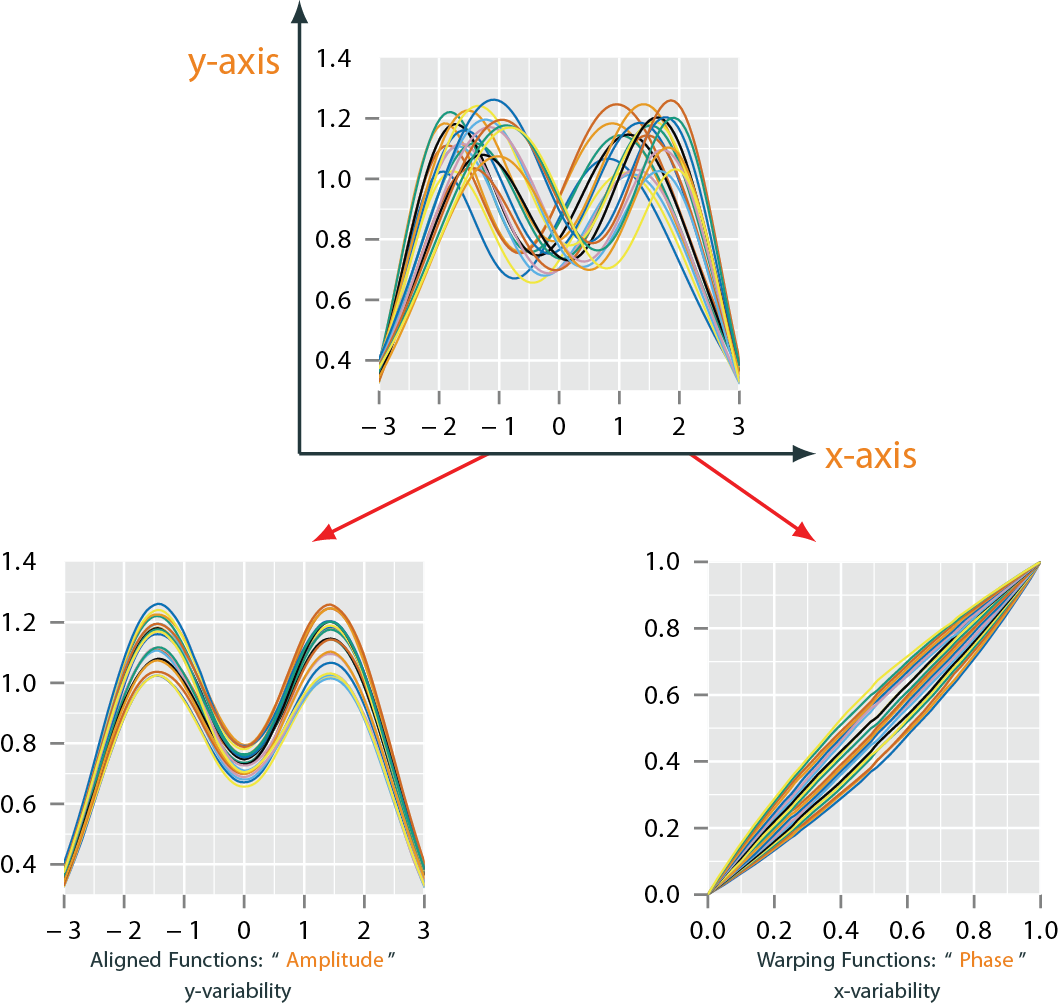
Functional Data Alignment
- There are few different methods that have been proposed (Ramsay, Mueller, Srivastava)
- We will focus on Elastic Method of (Srivastava, Wu, Tucker, Kurtek) as it uses a proper metric
- Let elements of the group \(\Gamma\) play the role of warping functions as the set of boundary-preserving diffeomorphisms, \(\gamma: [0,1] \to [0,1]\)
- For any \(f\), the operation, \(f\circ\gamma\) denotes the time warping of \(f\) by \(\gamma\)
Functional Data Alignment
- Problem: Under the standard \({\mathbb{L}^2}\) metric,
- The action of \(\Gamma\) does not act by isometries since \(\| f_1\circ \gamma - f_2 \circ \gamma\|\neq\| f_1 - f_2 \|\)
- Solutions:
- Use the square-root slope function or SRSF of \(f\) \[ q(t) = \mbox{sign}(\dot{f}(t)) \sqrt{ |\dot{f}(t)|} \]
- where \(\| q_1 - q_2 \| = \| (q_1, \gamma) - (q_2, \gamma) \|\) and \((q_1, \gamma) = (q_1 \circ \gamma)\sqrt{\dot{\gamma}}\)
- Leads to a distance on \({\mathcal F}/ \Gamma\): \(d_a(f_1, f_2) = \inf_{\gamma \in \Gamma} \|q_1 - (q_2,\gamma)\|\)
Pinching Problem
- Why use the ?
- The \({\mathbb{L}^2}\) distance is a proper distance
- The action of \(\Gamma\) does act by isometries
- Solves the pinching problem
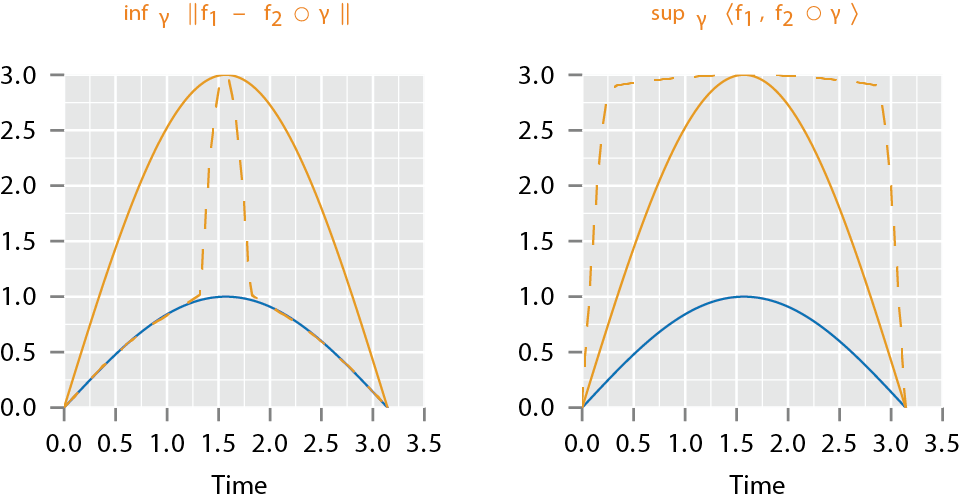
Elastic Function Alignment
- Alignment:
- Alignment is performed by finding the empirical Karcher mean \[ \mu_q = \mathop{\mathrm{arg\,min}}_{q \in {\mathbb{L}^2}} \sum_{i=1}^n \left( \inf_{\gamma_i \in \Gamma} \| q - (q_i, \gamma_i) \|^2 \right)\]
- Note that if \({\mu}_q\) is a minimizer of the cost function, then so is \(({\mu}_q ,\gamma)\) for any \(\gamma \in \Gamma\) since the metric is invariant to random warpings
- To make the choice unique we choose the \(\mu_q\) of the set \(\{ (\mu_q,\gamma) | \gamma \in \Gamma\}\) such that the mean of \(\{\gamma_i^*\}\) is identity
Elastic Function Alignment

Modeling using Phase & Amplitude Separation
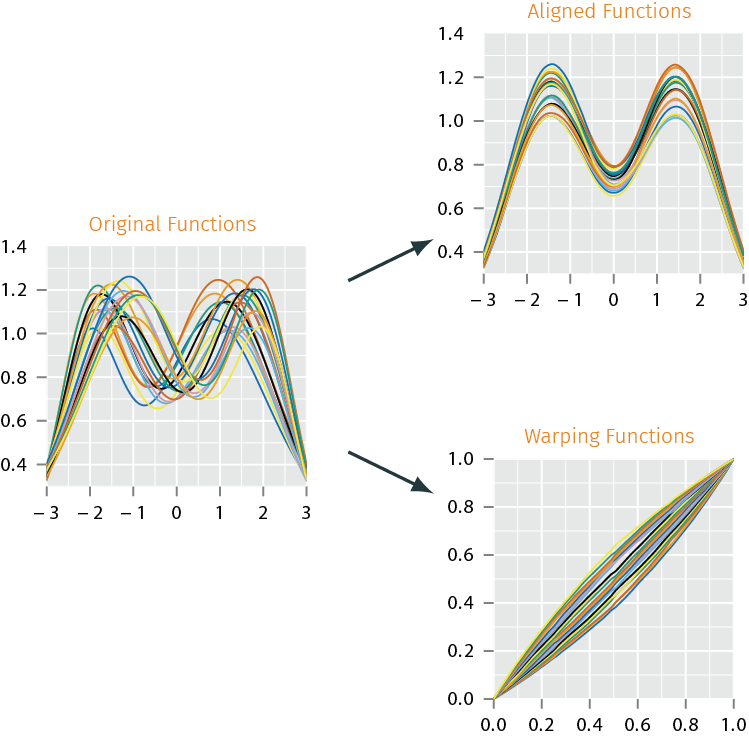
Modeling using Phase & Amplitude Separation

Modeling using Phase & Amplitude Separation
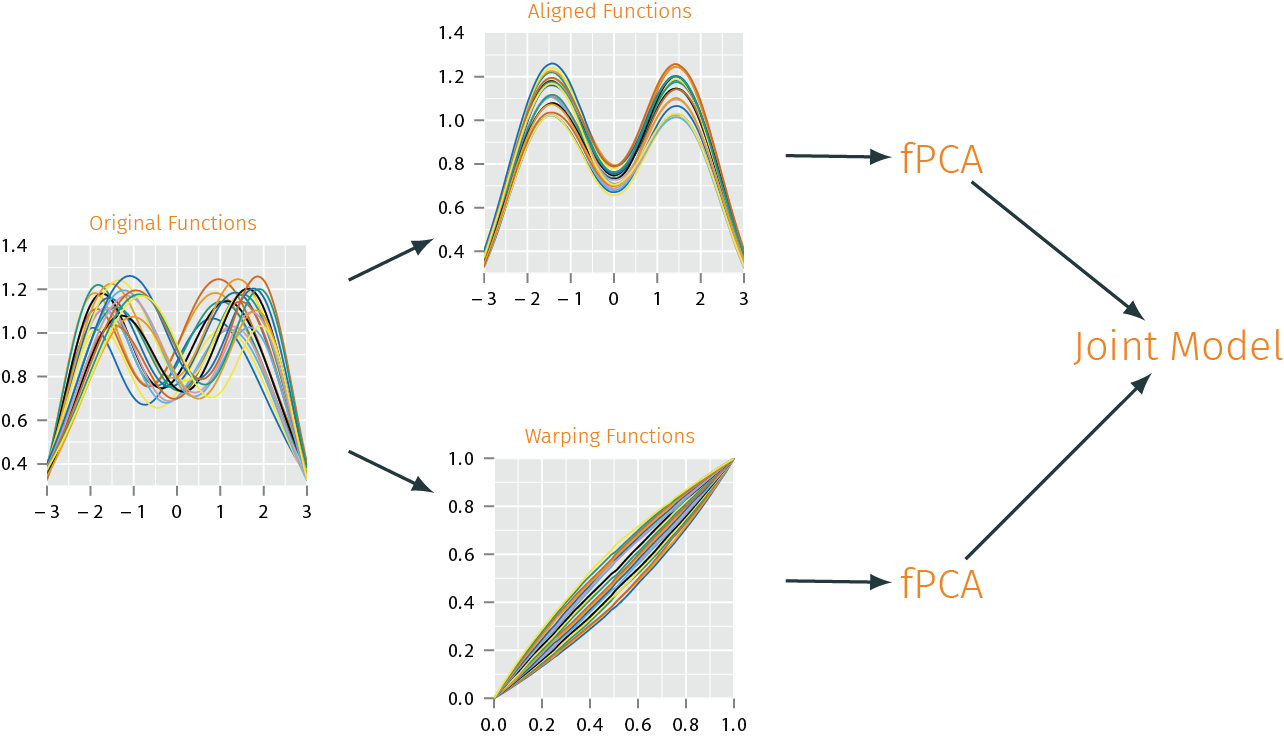
Analysis of Warping Functions (Phase)
- Horizontal fPCA: Analysis of Warping Functions
- Use SRSF of warping functions, \(\psi = \sqrt{\dot{\gamma}}\)
- Karcher Mean: \(\gamma \mapsto \sum_{i=1}^n d_p(\gamma, \gamma_i)^2\)
- Tangent Space:\(T_{\psi}({\mathbb{S}}_{\infty}) = \{v \in {\mathbb{L}^2}| \int_0^1 v(t) \psi(t) dt = 0\}\)
- Sample Covariance Function: \((t_1, t_2) \mapsto \frac{1}{n-1} \sum_{i=1}^n v_i(t_1) v_i(t_2)\)
- Take SVD of \(K_{\psi} = U_{\psi} \Sigma_{\psi} V_{\psi}^{\mathsf{T}}\) provides the estimated principal components

Why SRSF of \(\gamma_i\)
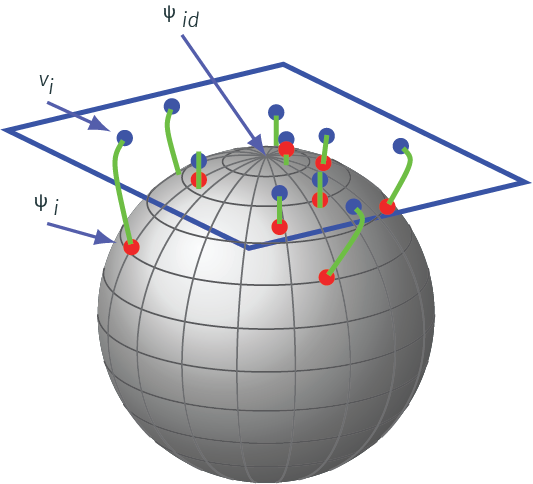
- \(\Gamma\) is a nonlinear manifold and it is infinite dimensional
- Represent an element \(\gamma \in \Gamma\) by the square-root of its derivative \(\psi = \sqrt{\dot{\gamma}}\)
- Important advantage of this transformation is that set of all such \(\psi\)s is a Hilbert sphere \({\mathbb{S}}_{\infty}\)
Analysis of Aligned Functions (Amplitude)
- Vertical fPCA: Analysis of Aligned Functions
- Need variability associated with the initial values (\(\{f_i(0)\}\))
- Analyze the aligned pair \(\tilde{h} = [\tilde{q}_i~~f_i(0)]\) such that mapping from the function space \({\mathcal{F}}\) to \({\mathbb{L}^2}\times \mathbb{R}\) is a bijection \[ K_h = \frac{1}{n-1}\sum_{i=1}^n E[(\tilde{h}_i - \mu_h)(\tilde{h}_i - \mu_h)^{\mathsf{T}}] \in \mathbb{R}^{(T+1) \times (T+1)} \]
- Taking the SVD, \(K_h=U_h\Sigma_h V_h^{\mathsf{T}}\) we can calculate the directions of principle variability
- Need variability associated with the initial values (\(\{f_i(0)\}\))
Analysis of Aligned Functions (Amplitude)

Sampling from Joint Model
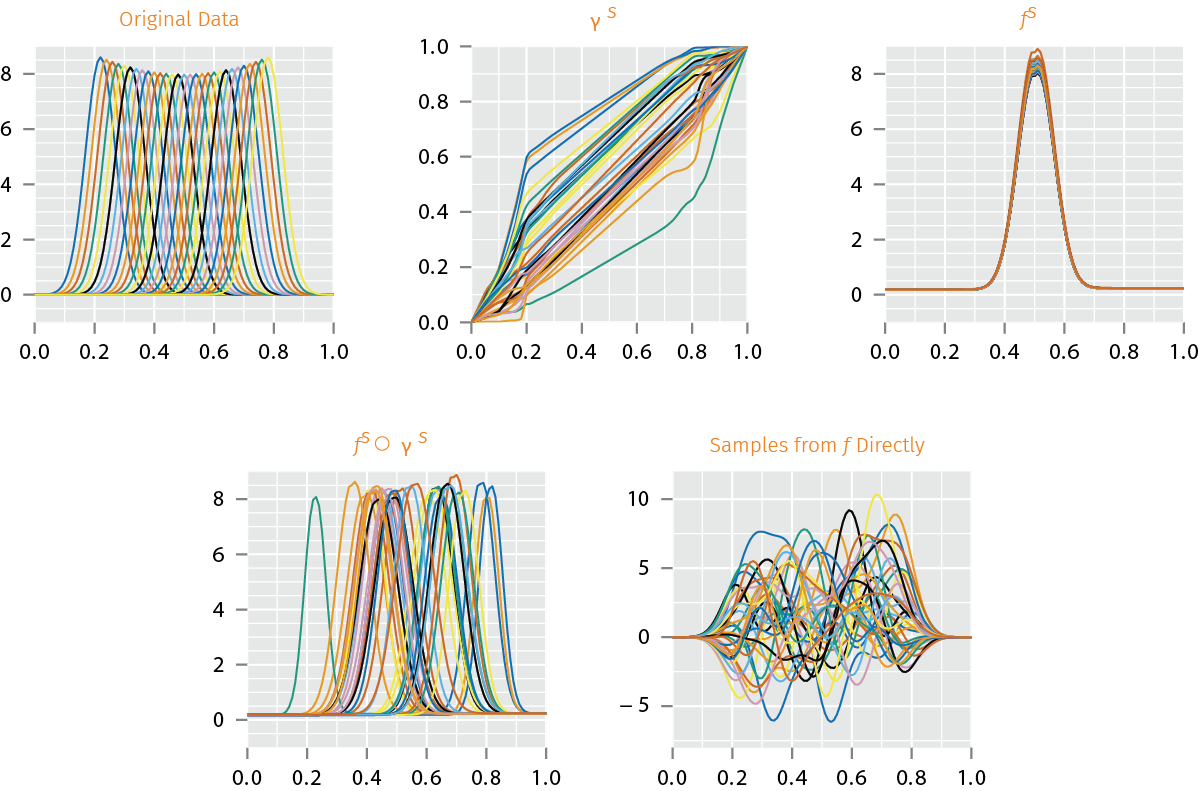
- Random samples from jointly Gaussian models on fPCA coefficients of \(\gamma^s\) and \(f^s\), and their combinations \(f^s \circ \gamma^s\), with samples from \(f\) directly.
Summary
- FDA is a very important problem area for statistics
- Can perform statistics using functions, but have to be aware of different set of issues/nuances
- Functional data often comes with phase variability that cannot be handled using standard L2 framework
- Elastic FDA provides more flexibility than classical FDA
- Amongst the best alignment methods
- Also provides joint solutions for inferences along with alignments
- Theory and Methods work for functions, curves, surfaces, and images
Questions?
jdtuck@sandia.gov
http://research.tetonedge.net
